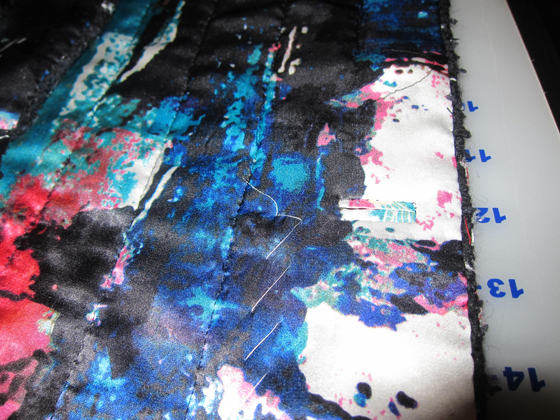Hi, readers! Kids are delivered to respective educational institutions after demanding double attention yesterday, and I finally got some time to share with you! Yay!
This U.F.O. celebration worked so far, my cape is finished! Now, I could not make up my mind which project to tackle next - that's always my problem. I wish I had a wardrobe full of beautiful hand-made clothes, but, alas...
So, at the end, I settled with my Clovers. Remember, it was a bonus project for Colette Fall Palette Challenge. Hmmm... So far, I have been working on bonus projects only, not on the planned ones. But, on the other hand, I do need an extra pair or two of trousers, so here we go.
The muslin was done long ago, fabric cut, pants underlined. What slowed me down is the decision on how to finish the seams. You know me, I love to use couture techniques - so, my initial thought was to hand overcast the seams. Crazy, right?
I checked David Page Coffin's Making Trousers for Men & Women: A Multimedia Sewing Workshop - he has a great chapter at the beginning 'Learning from Custom and Ready-to-Wear Garments'. And, of course, what I found there? YSL couture pants from Claire Shaeffer's collection!!! Naturally, all seam allowances were hand overcast... But I just wasn't ready for hand overcasting some five yards of seams with winter approaching soon.... I thought, those YSL pants are vintage - do they really still hand overcast? The answer is, most likely, yes, readers... (I've seen it in documentaries - but I tried to suppress it) So, I was still looking for faster solution. I feel really, really guilty about it!
- he has a great chapter at the beginning 'Learning from Custom and Ready-to-Wear Garments'. And, of course, what I found there? YSL couture pants from Claire Shaeffer's collection!!! Naturally, all seam allowances were hand overcast... But I just wasn't ready for hand overcasting some five yards of seams with winter approaching soon.... I thought, those YSL pants are vintage - do they really still hand overcast? The answer is, most likely, yes, readers... (I've seen it in documentaries - but I tried to suppress it) So, I was still looking for faster solution. I feel really, really guilty about it!
Let me explain, readers! Hand overcasting considerably reduces bulk and stiffness of the seam edge, which is, obviously, an advantage as it won't show through on lighter weight fabrics, or leave an impression after pressing. However, my trousers, are made of medium-weight stretch tweed, and are underlined, so bulk is a relative issue. Stiffness, maybe.
I went further and paid a mandatory visit to The Cutter & Tailor forum for some advice. I mean who would know better than a bunch of best custom tailors?! There was a discussion on seam finishes, and I finally found what I was looking for.
Is sewing too trivial for a suspense moment, readers?.. Ta-da-da-DAM!
...Anyway,.. I decided to go for serging {Did I say the s* word?} Sorry!.. well, yes, s*rging! However, I used fine silk thread instead of the bulkier polyester. It made soo much difference. It's not as pure (forgive me) as hand overcasting, but it is only tiny little bit bulky and only somewhat stiff.
Of course, it took me several samples to adjust the tension - the thread was breaking all the time. At the end, I got it. Here is the proof:
To conclude, I just wanted to say that I would have chosen hand overcasting the pants if I had more time. Purist or not, to me it seems to be a better finish!
Now, back to you, readers! How do you finish pant seams? What are the pros and cons of your method?
This U.F.O. celebration worked so far, my cape is finished! Now, I could not make up my mind which project to tackle next - that's always my problem. I wish I had a wardrobe full of beautiful hand-made clothes, but, alas...
So, at the end, I settled with my Clovers. Remember, it was a bonus project for Colette Fall Palette Challenge. Hmmm... So far, I have been working on bonus projects only, not on the planned ones. But, on the other hand, I do need an extra pair or two of trousers, so here we go.
The muslin was done long ago, fabric cut, pants underlined. What slowed me down is the decision on how to finish the seams. You know me, I love to use couture techniques - so, my initial thought was to hand overcast the seams. Crazy, right?
I checked David Page Coffin's Making Trousers for Men & Women: A Multimedia Sewing Workshop
Let me explain, readers! Hand overcasting considerably reduces bulk and stiffness of the seam edge, which is, obviously, an advantage as it won't show through on lighter weight fabrics, or leave an impression after pressing. However, my trousers, are made of medium-weight stretch tweed, and are underlined, so bulk is a relative issue. Stiffness, maybe.
I went further and paid a mandatory visit to The Cutter & Tailor forum for some advice. I mean who would know better than a bunch of best custom tailors?! There was a discussion on seam finishes, and I finally found what I was looking for.
Is sewing too trivial for a suspense moment, readers?.. Ta-da-da-DAM!
...Anyway,.. I decided to go for serging {Did I say the s* word?} Sorry!.. well, yes, s*rging! However, I used fine silk thread instead of the bulkier polyester. It made soo much difference. It's not as pure (forgive me) as hand overcasting, but it is only tiny little bit bulky and only somewhat stiff.
Of course, it took me several samples to adjust the tension - the thread was breaking all the time. At the end, I got it. Here is the proof:
 |
| well, the face side is not that visible, but what's more important is that it's not bulky or stiff. |
Now, back to you, readers! How do you finish pant seams? What are the pros and cons of your method?

























